PHCA9507 Flinders: Climate Change and Community Vulnerability Report
VerifiedAdded on 2023/01/12
|12
|3182
|78
Report
AI Summary
This report delves into the pressing issue of climate change and its profound impact on community vulnerability. It highlights the global effects of climate change, including shifting weather patterns and rising sea levels, emphasizing the consequent threats to human and community health. The paper explores the use of the 'creating supportive environments strategy' as a method to mitigate health risks. It analyzes the shift in environmental patterns since the Ottawa Charter, emphasizing the need for preventative measures to reduce environmental degradation and protect communities from climate change-related health risks like skin cancer. The report emphasizes the interconnectedness of communities and their environments, stressing the importance of environmental conservation for public health. It details strategies such as technological monitoring, workplace modifications, and energy production monitoring to create supportive environments. The report also examines the impact of urbanization and proposes health-promoting factors in urban development. Finally, it includes a table that shows health outcomes concerning climate change such as food and waterborne diseases, vector-borne diseases, and natural disasters.
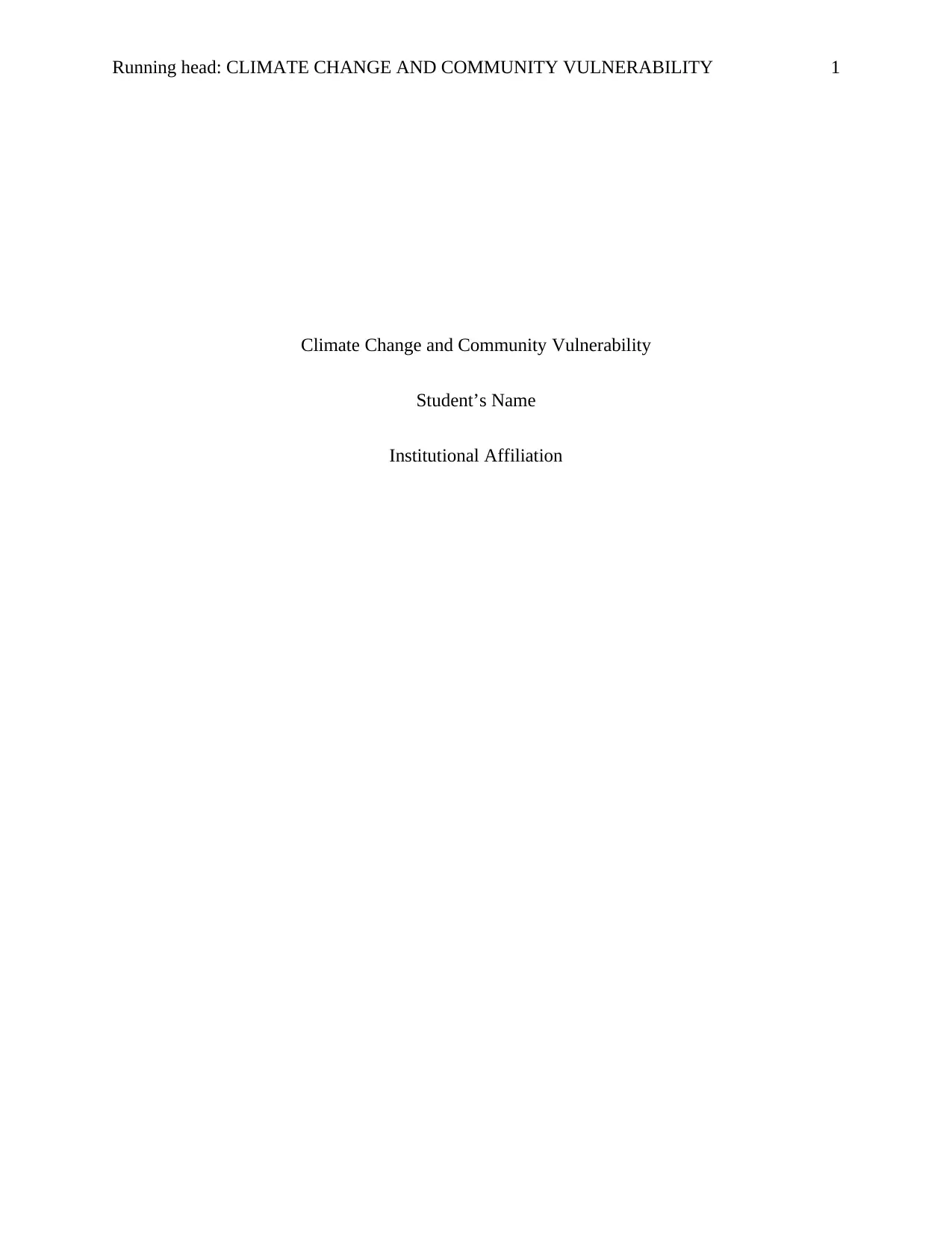
Running head: CLIMATE CHANGE AND COMMUNITY VULNERABILITY 1
Climate Change and Community Vulnerability
Student’s Name
Institutional Affiliation
Climate Change and Community Vulnerability
Student’s Name
Institutional Affiliation
Paraphrase This Document
Need a fresh take? Get an instant paraphrase of this document with our AI Paraphraser
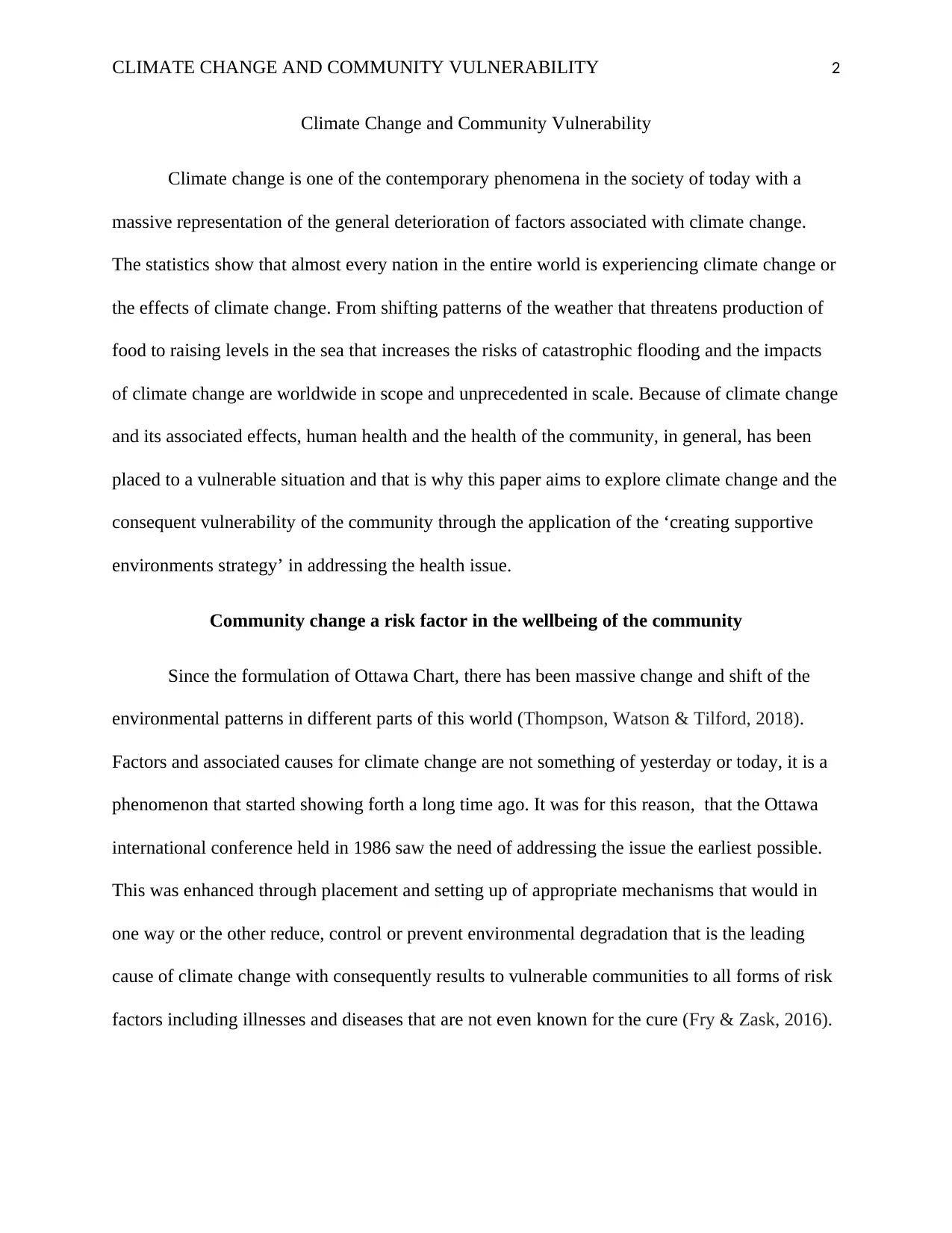
CLIMATE CHANGE AND COMMUNITY VULNERABILITY 2
Climate Change and Community Vulnerability
Climate change is one of the contemporary phenomena in the society of today with a
massive representation of the general deterioration of factors associated with climate change.
The statistics show that almost every nation in the entire world is experiencing climate change or
the effects of climate change. From shifting patterns of the weather that threatens production of
food to raising levels in the sea that increases the risks of catastrophic flooding and the impacts
of climate change are worldwide in scope and unprecedented in scale. Because of climate change
and its associated effects, human health and the health of the community, in general, has been
placed to a vulnerable situation and that is why this paper aims to explore climate change and the
consequent vulnerability of the community through the application of the ‘creating supportive
environments strategy’ in addressing the health issue.
Community change a risk factor in the wellbeing of the community
Since the formulation of Ottawa Chart, there has been massive change and shift of the
environmental patterns in different parts of this world (Thompson, Watson & Tilford, 2018).
Factors and associated causes for climate change are not something of yesterday or today, it is a
phenomenon that started showing forth a long time ago. It was for this reason, that the Ottawa
international conference held in 1986 saw the need of addressing the issue the earliest possible.
This was enhanced through placement and setting up of appropriate mechanisms that would in
one way or the other reduce, control or prevent environmental degradation that is the leading
cause of climate change with consequently results to vulnerable communities to all forms of risk
factors including illnesses and diseases that are not even known for the cure (Fry & Zask, 2016).
Climate Change and Community Vulnerability
Climate change is one of the contemporary phenomena in the society of today with a
massive representation of the general deterioration of factors associated with climate change.
The statistics show that almost every nation in the entire world is experiencing climate change or
the effects of climate change. From shifting patterns of the weather that threatens production of
food to raising levels in the sea that increases the risks of catastrophic flooding and the impacts
of climate change are worldwide in scope and unprecedented in scale. Because of climate change
and its associated effects, human health and the health of the community, in general, has been
placed to a vulnerable situation and that is why this paper aims to explore climate change and the
consequent vulnerability of the community through the application of the ‘creating supportive
environments strategy’ in addressing the health issue.
Community change a risk factor in the wellbeing of the community
Since the formulation of Ottawa Chart, there has been massive change and shift of the
environmental patterns in different parts of this world (Thompson, Watson & Tilford, 2018).
Factors and associated causes for climate change are not something of yesterday or today, it is a
phenomenon that started showing forth a long time ago. It was for this reason, that the Ottawa
international conference held in 1986 saw the need of addressing the issue the earliest possible.
This was enhanced through placement and setting up of appropriate mechanisms that would in
one way or the other reduce, control or prevent environmental degradation that is the leading
cause of climate change with consequently results to vulnerable communities to all forms of risk
factors including illnesses and diseases that are not even known for the cure (Fry & Zask, 2016).
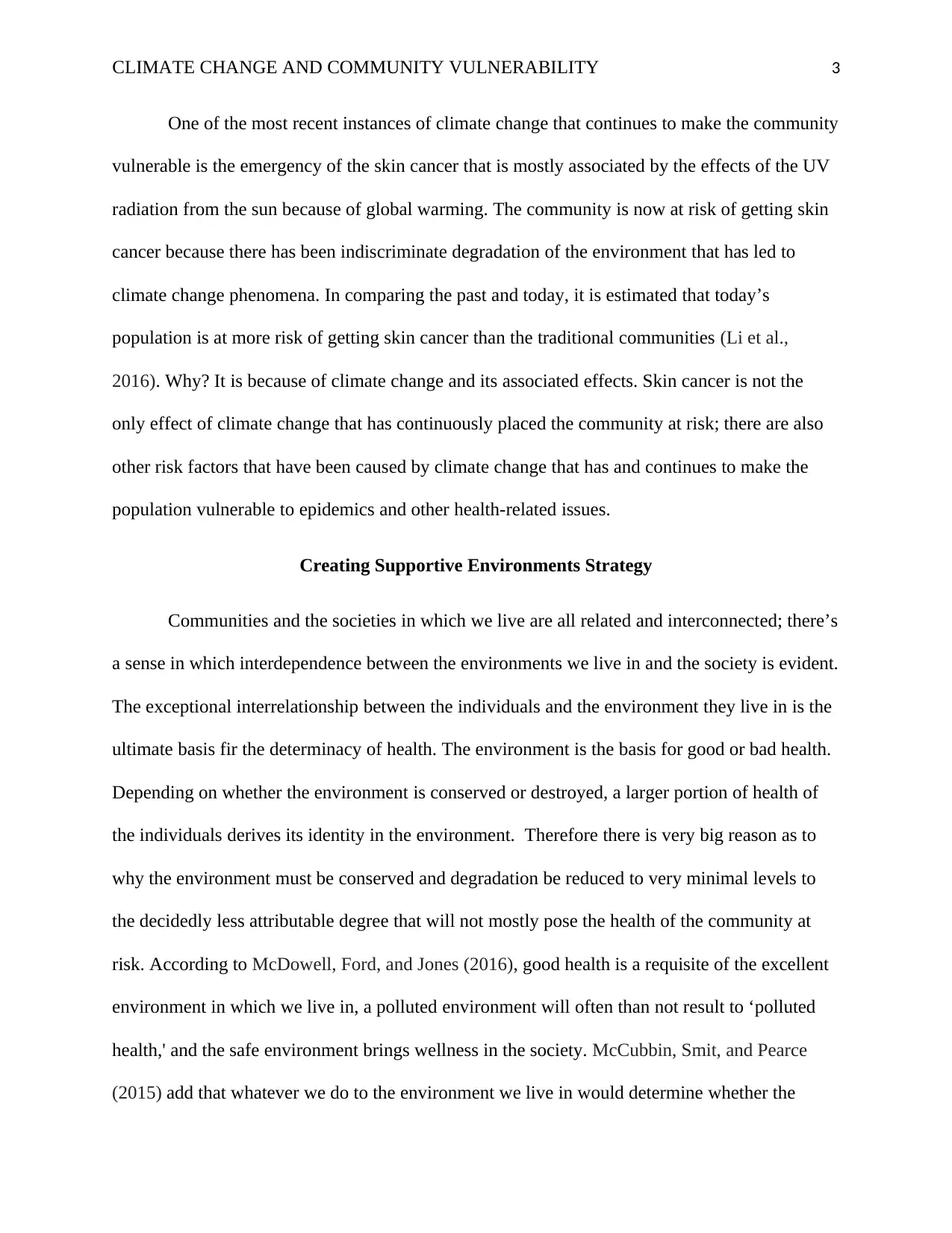
CLIMATE CHANGE AND COMMUNITY VULNERABILITY 3
One of the most recent instances of climate change that continues to make the community
vulnerable is the emergency of the skin cancer that is mostly associated by the effects of the UV
radiation from the sun because of global warming. The community is now at risk of getting skin
cancer because there has been indiscriminate degradation of the environment that has led to
climate change phenomena. In comparing the past and today, it is estimated that today’s
population is at more risk of getting skin cancer than the traditional communities (Li et al.,
2016). Why? It is because of climate change and its associated effects. Skin cancer is not the
only effect of climate change that has continuously placed the community at risk; there are also
other risk factors that have been caused by climate change that has and continues to make the
population vulnerable to epidemics and other health-related issues.
Creating Supportive Environments Strategy
Communities and the societies in which we live are all related and interconnected; there’s
a sense in which interdependence between the environments we live in and the society is evident.
The exceptional interrelationship between the individuals and the environment they live in is the
ultimate basis fir the determinacy of health. The environment is the basis for good or bad health.
Depending on whether the environment is conserved or destroyed, a larger portion of health of
the individuals derives its identity in the environment. Therefore there is very big reason as to
why the environment must be conserved and degradation be reduced to very minimal levels to
the decidedly less attributable degree that will not mostly pose the health of the community at
risk. According to McDowell, Ford, and Jones (2016), good health is a requisite of the excellent
environment in which we live in, a polluted environment will often than not result to ‘polluted
health,' and the safe environment brings wellness in the society. McCubbin, Smit, and Pearce
(2015) add that whatever we do to the environment we live in would determine whether the
One of the most recent instances of climate change that continues to make the community
vulnerable is the emergency of the skin cancer that is mostly associated by the effects of the UV
radiation from the sun because of global warming. The community is now at risk of getting skin
cancer because there has been indiscriminate degradation of the environment that has led to
climate change phenomena. In comparing the past and today, it is estimated that today’s
population is at more risk of getting skin cancer than the traditional communities (Li et al.,
2016). Why? It is because of climate change and its associated effects. Skin cancer is not the
only effect of climate change that has continuously placed the community at risk; there are also
other risk factors that have been caused by climate change that has and continues to make the
population vulnerable to epidemics and other health-related issues.
Creating Supportive Environments Strategy
Communities and the societies in which we live are all related and interconnected; there’s
a sense in which interdependence between the environments we live in and the society is evident.
The exceptional interrelationship between the individuals and the environment they live in is the
ultimate basis fir the determinacy of health. The environment is the basis for good or bad health.
Depending on whether the environment is conserved or destroyed, a larger portion of health of
the individuals derives its identity in the environment. Therefore there is very big reason as to
why the environment must be conserved and degradation be reduced to very minimal levels to
the decidedly less attributable degree that will not mostly pose the health of the community at
risk. According to McDowell, Ford, and Jones (2016), good health is a requisite of the excellent
environment in which we live in, a polluted environment will often than not result to ‘polluted
health,' and the safe environment brings wellness in the society. McCubbin, Smit, and Pearce
(2015) add that whatever we do to the environment we live in would determine whether the
⊘ This is a preview!⊘
Do you want full access?
Subscribe today to unlock all pages.

Trusted by 1+ million students worldwide
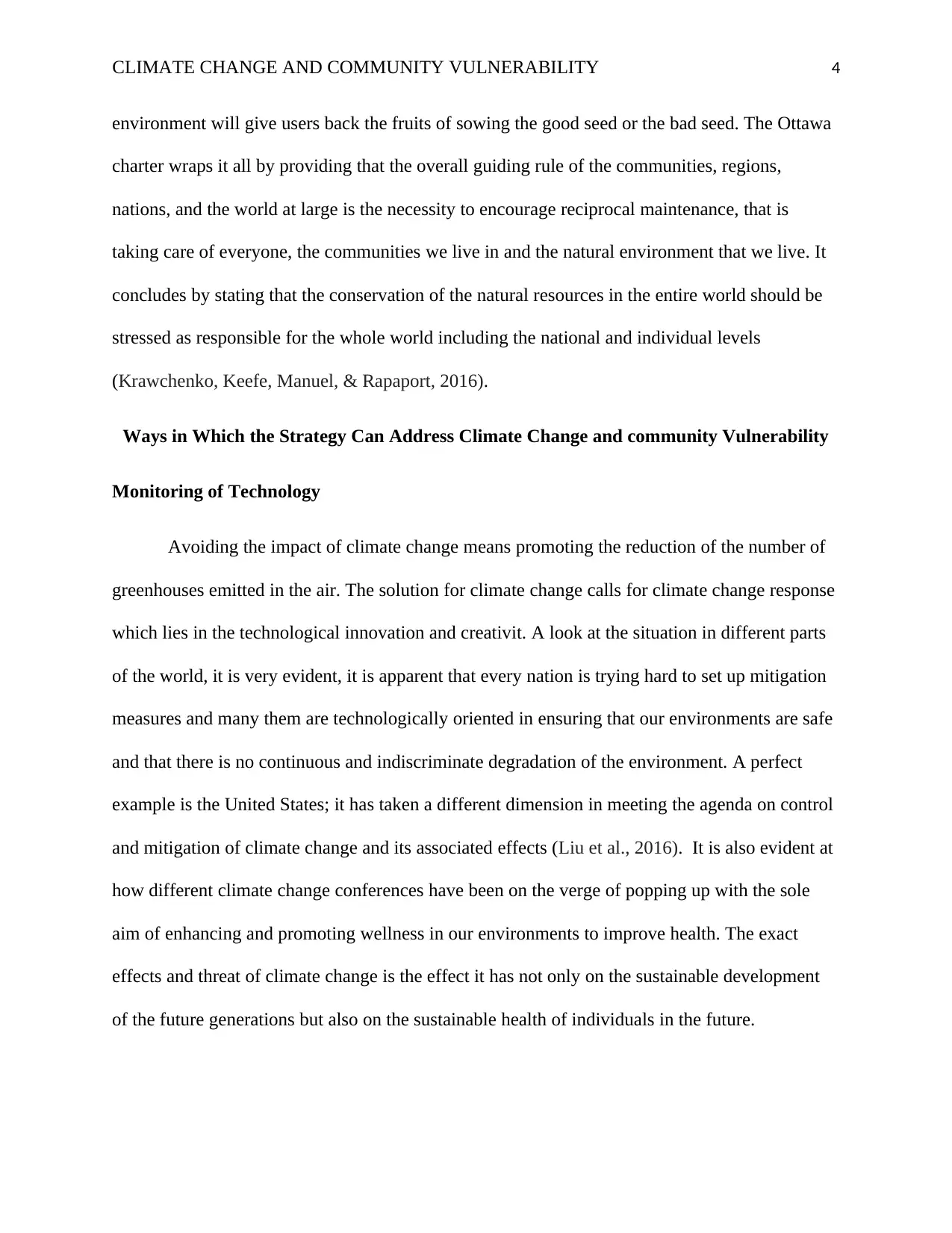
CLIMATE CHANGE AND COMMUNITY VULNERABILITY 4
environment will give users back the fruits of sowing the good seed or the bad seed. The Ottawa
charter wraps it all by providing that the overall guiding rule of the communities, regions,
nations, and the world at large is the necessity to encourage reciprocal maintenance, that is
taking care of everyone, the communities we live in and the natural environment that we live. It
concludes by stating that the conservation of the natural resources in the entire world should be
stressed as responsible for the whole world including the national and individual levels
(Krawchenko, Keefe, Manuel, & Rapaport, 2016).
Ways in Which the Strategy Can Address Climate Change and community Vulnerability
Monitoring of Technology
Avoiding the impact of climate change means promoting the reduction of the number of
greenhouses emitted in the air. The solution for climate change calls for climate change response
which lies in the technological innovation and creativit. A look at the situation in different parts
of the world, it is very evident, it is apparent that every nation is trying hard to set up mitigation
measures and many them are technologically oriented in ensuring that our environments are safe
and that there is no continuous and indiscriminate degradation of the environment. A perfect
example is the United States; it has taken a different dimension in meeting the agenda on control
and mitigation of climate change and its associated effects (Liu et al., 2016). It is also evident at
how different climate change conferences have been on the verge of popping up with the sole
aim of enhancing and promoting wellness in our environments to improve health. The exact
effects and threat of climate change is the effect it has not only on the sustainable development
of the future generations but also on the sustainable health of individuals in the future.
environment will give users back the fruits of sowing the good seed or the bad seed. The Ottawa
charter wraps it all by providing that the overall guiding rule of the communities, regions,
nations, and the world at large is the necessity to encourage reciprocal maintenance, that is
taking care of everyone, the communities we live in and the natural environment that we live. It
concludes by stating that the conservation of the natural resources in the entire world should be
stressed as responsible for the whole world including the national and individual levels
(Krawchenko, Keefe, Manuel, & Rapaport, 2016).
Ways in Which the Strategy Can Address Climate Change and community Vulnerability
Monitoring of Technology
Avoiding the impact of climate change means promoting the reduction of the number of
greenhouses emitted in the air. The solution for climate change calls for climate change response
which lies in the technological innovation and creativit. A look at the situation in different parts
of the world, it is very evident, it is apparent that every nation is trying hard to set up mitigation
measures and many them are technologically oriented in ensuring that our environments are safe
and that there is no continuous and indiscriminate degradation of the environment. A perfect
example is the United States; it has taken a different dimension in meeting the agenda on control
and mitigation of climate change and its associated effects (Liu et al., 2016). It is also evident at
how different climate change conferences have been on the verge of popping up with the sole
aim of enhancing and promoting wellness in our environments to improve health. The exact
effects and threat of climate change is the effect it has not only on the sustainable development
of the future generations but also on the sustainable health of individuals in the future.
Paraphrase This Document
Need a fresh take? Get an instant paraphrase of this document with our AI Paraphraser
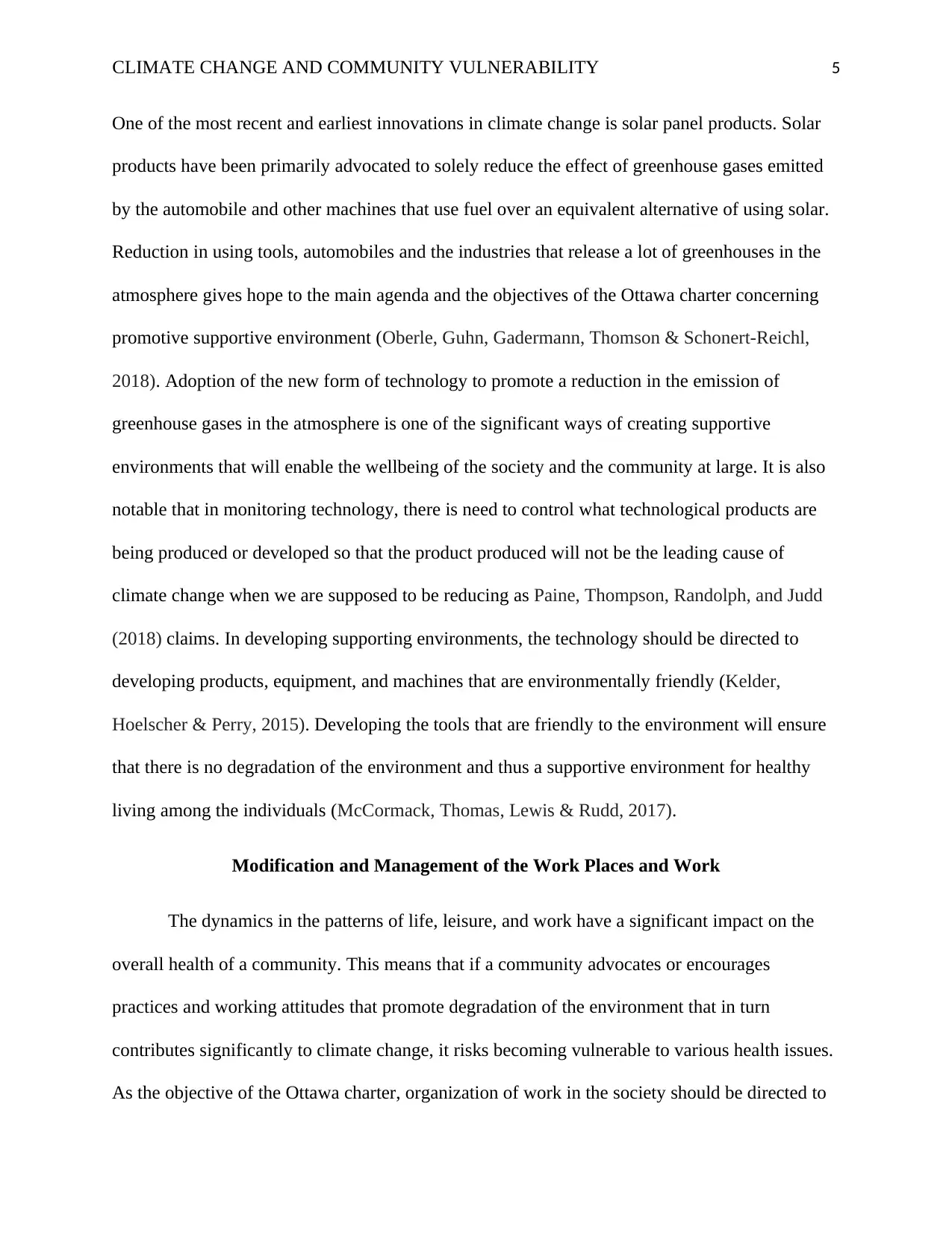
CLIMATE CHANGE AND COMMUNITY VULNERABILITY 5
One of the most recent and earliest innovations in climate change is solar panel products. Solar
products have been primarily advocated to solely reduce the effect of greenhouse gases emitted
by the automobile and other machines that use fuel over an equivalent alternative of using solar.
Reduction in using tools, automobiles and the industries that release a lot of greenhouses in the
atmosphere gives hope to the main agenda and the objectives of the Ottawa charter concerning
promotive supportive environment (Oberle, Guhn, Gadermann, Thomson & Schonert-Reichl,
2018). Adoption of the new form of technology to promote a reduction in the emission of
greenhouse gases in the atmosphere is one of the significant ways of creating supportive
environments that will enable the wellbeing of the society and the community at large. It is also
notable that in monitoring technology, there is need to control what technological products are
being produced or developed so that the product produced will not be the leading cause of
climate change when we are supposed to be reducing as Paine, Thompson, Randolph, and Judd
(2018) claims. In developing supporting environments, the technology should be directed to
developing products, equipment, and machines that are environmentally friendly (Kelder,
Hoelscher & Perry, 2015). Developing the tools that are friendly to the environment will ensure
that there is no degradation of the environment and thus a supportive environment for healthy
living among the individuals (McCormack, Thomas, Lewis & Rudd, 2017).
Modification and Management of the Work Places and Work
The dynamics in the patterns of life, leisure, and work have a significant impact on the
overall health of a community. This means that if a community advocates or encourages
practices and working attitudes that promote degradation of the environment that in turn
contributes significantly to climate change, it risks becoming vulnerable to various health issues.
As the objective of the Ottawa charter, organization of work in the society should be directed to
One of the most recent and earliest innovations in climate change is solar panel products. Solar
products have been primarily advocated to solely reduce the effect of greenhouse gases emitted
by the automobile and other machines that use fuel over an equivalent alternative of using solar.
Reduction in using tools, automobiles and the industries that release a lot of greenhouses in the
atmosphere gives hope to the main agenda and the objectives of the Ottawa charter concerning
promotive supportive environment (Oberle, Guhn, Gadermann, Thomson & Schonert-Reichl,
2018). Adoption of the new form of technology to promote a reduction in the emission of
greenhouse gases in the atmosphere is one of the significant ways of creating supportive
environments that will enable the wellbeing of the society and the community at large. It is also
notable that in monitoring technology, there is need to control what technological products are
being produced or developed so that the product produced will not be the leading cause of
climate change when we are supposed to be reducing as Paine, Thompson, Randolph, and Judd
(2018) claims. In developing supporting environments, the technology should be directed to
developing products, equipment, and machines that are environmentally friendly (Kelder,
Hoelscher & Perry, 2015). Developing the tools that are friendly to the environment will ensure
that there is no degradation of the environment and thus a supportive environment for healthy
living among the individuals (McCormack, Thomas, Lewis & Rudd, 2017).
Modification and Management of the Work Places and Work
The dynamics in the patterns of life, leisure, and work have a significant impact on the
overall health of a community. This means that if a community advocates or encourages
practices and working attitudes that promote degradation of the environment that in turn
contributes significantly to climate change, it risks becoming vulnerable to various health issues.
As the objective of the Ottawa charter, organization of work in the society should be directed to
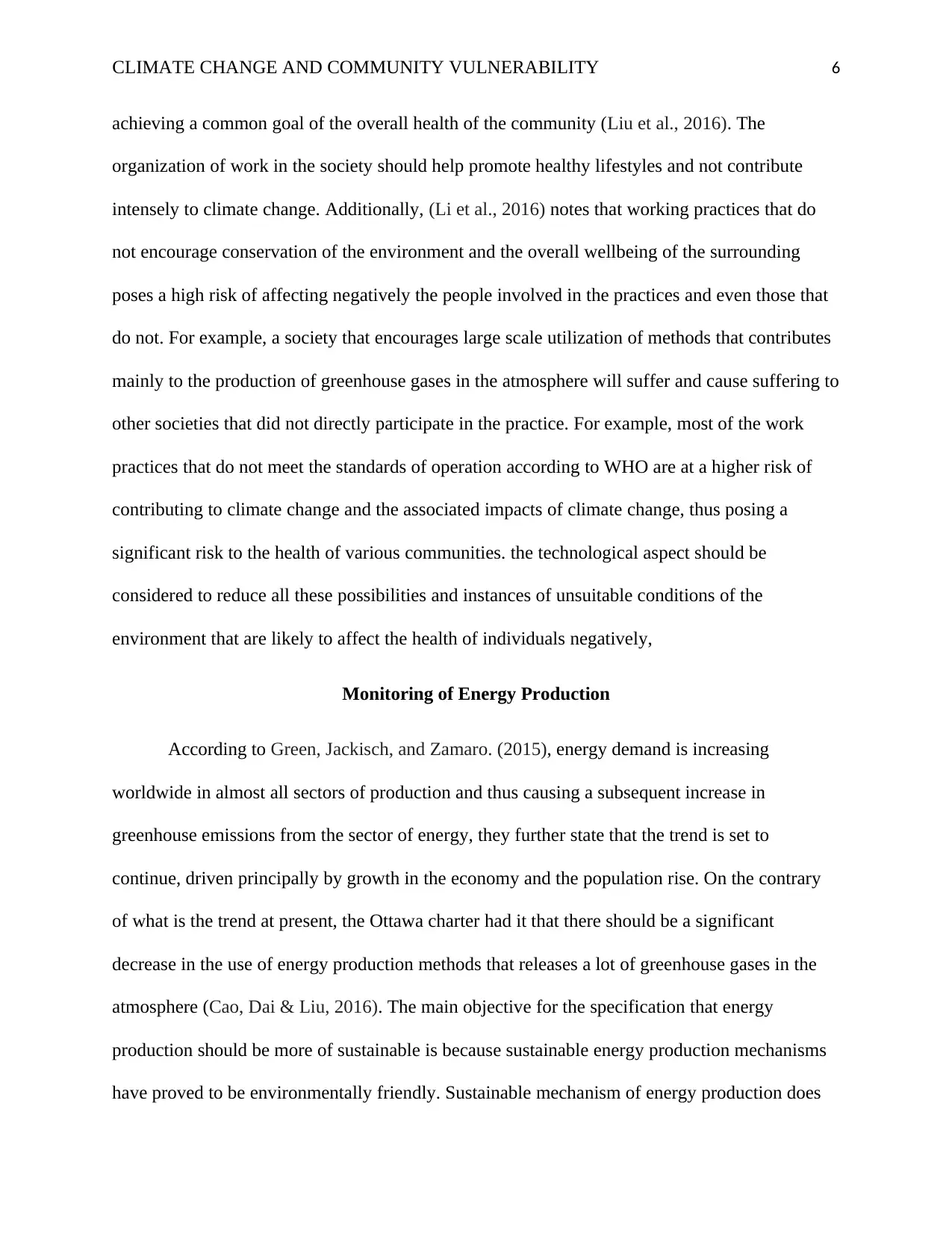
CLIMATE CHANGE AND COMMUNITY VULNERABILITY 6
achieving a common goal of the overall health of the community (Liu et al., 2016). The
organization of work in the society should help promote healthy lifestyles and not contribute
intensely to climate change. Additionally, (Li et al., 2016) notes that working practices that do
not encourage conservation of the environment and the overall wellbeing of the surrounding
poses a high risk of affecting negatively the people involved in the practices and even those that
do not. For example, a society that encourages large scale utilization of methods that contributes
mainly to the production of greenhouse gases in the atmosphere will suffer and cause suffering to
other societies that did not directly participate in the practice. For example, most of the work
practices that do not meet the standards of operation according to WHO are at a higher risk of
contributing to climate change and the associated impacts of climate change, thus posing a
significant risk to the health of various communities. the technological aspect should be
considered to reduce all these possibilities and instances of unsuitable conditions of the
environment that are likely to affect the health of individuals negatively,
Monitoring of Energy Production
According to Green, Jackisch, and Zamaro. (2015), energy demand is increasing
worldwide in almost all sectors of production and thus causing a subsequent increase in
greenhouse emissions from the sector of energy, they further state that the trend is set to
continue, driven principally by growth in the economy and the population rise. On the contrary
of what is the trend at present, the Ottawa charter had it that there should be a significant
decrease in the use of energy production methods that releases a lot of greenhouse gases in the
atmosphere (Cao, Dai & Liu, 2016). The main objective for the specification that energy
production should be more of sustainable is because sustainable energy production mechanisms
have proved to be environmentally friendly. Sustainable mechanism of energy production does
achieving a common goal of the overall health of the community (Liu et al., 2016). The
organization of work in the society should help promote healthy lifestyles and not contribute
intensely to climate change. Additionally, (Li et al., 2016) notes that working practices that do
not encourage conservation of the environment and the overall wellbeing of the surrounding
poses a high risk of affecting negatively the people involved in the practices and even those that
do not. For example, a society that encourages large scale utilization of methods that contributes
mainly to the production of greenhouse gases in the atmosphere will suffer and cause suffering to
other societies that did not directly participate in the practice. For example, most of the work
practices that do not meet the standards of operation according to WHO are at a higher risk of
contributing to climate change and the associated impacts of climate change, thus posing a
significant risk to the health of various communities. the technological aspect should be
considered to reduce all these possibilities and instances of unsuitable conditions of the
environment that are likely to affect the health of individuals negatively,
Monitoring of Energy Production
According to Green, Jackisch, and Zamaro. (2015), energy demand is increasing
worldwide in almost all sectors of production and thus causing a subsequent increase in
greenhouse emissions from the sector of energy, they further state that the trend is set to
continue, driven principally by growth in the economy and the population rise. On the contrary
of what is the trend at present, the Ottawa charter had it that there should be a significant
decrease in the use of energy production methods that releases a lot of greenhouse gases in the
atmosphere (Cao, Dai & Liu, 2016). The main objective for the specification that energy
production should be more of sustainable is because sustainable energy production mechanisms
have proved to be environmentally friendly. Sustainable mechanism of energy production does
⊘ This is a preview!⊘
Do you want full access?
Subscribe today to unlock all pages.

Trusted by 1+ million students worldwide
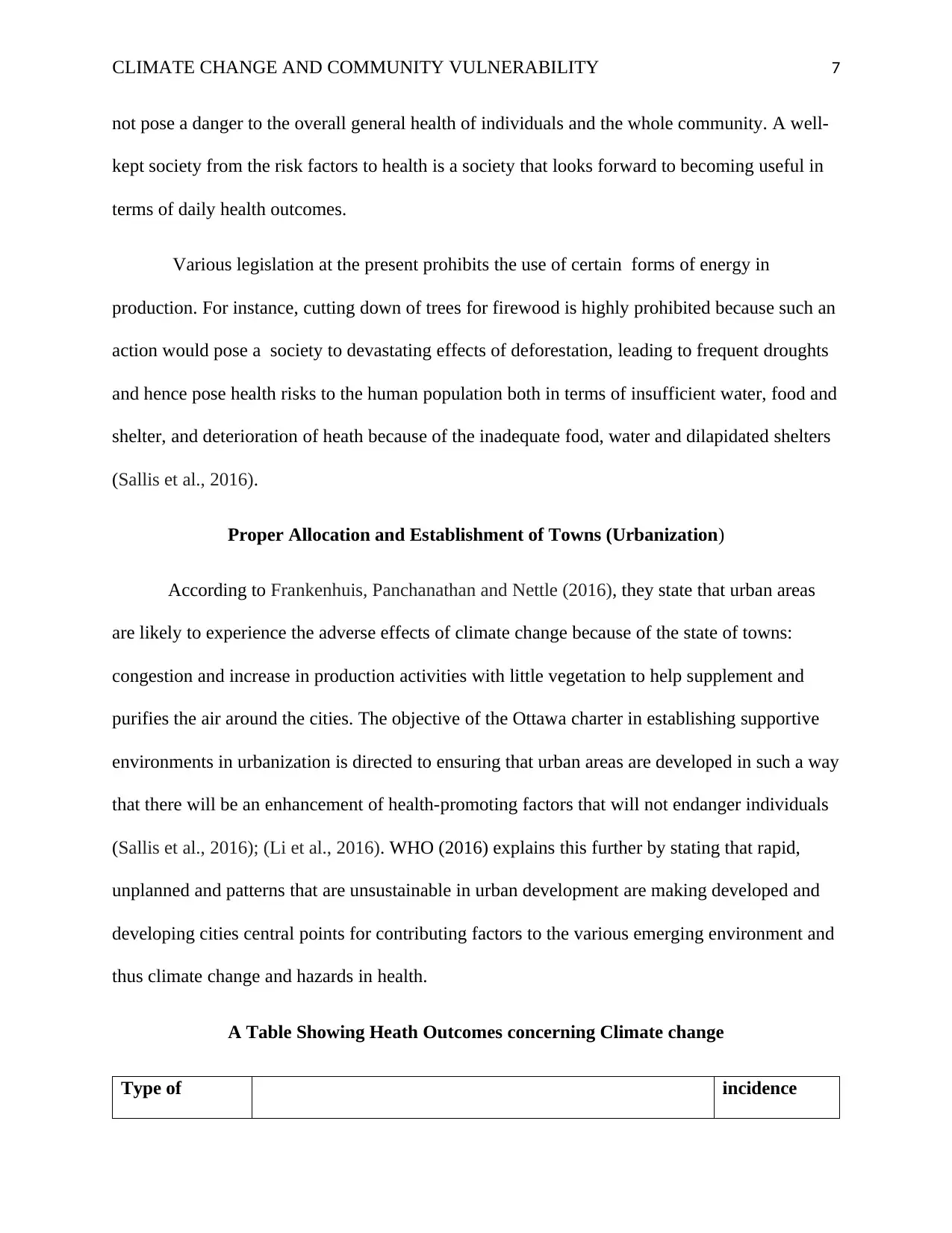
CLIMATE CHANGE AND COMMUNITY VULNERABILITY 7
not pose a danger to the overall general health of individuals and the whole community. A well-
kept society from the risk factors to health is a society that looks forward to becoming useful in
terms of daily health outcomes.
Various legislation at the present prohibits the use of certain forms of energy in
production. For instance, cutting down of trees for firewood is highly prohibited because such an
action would pose a society to devastating effects of deforestation, leading to frequent droughts
and hence pose health risks to the human population both in terms of insufficient water, food and
shelter, and deterioration of heath because of the inadequate food, water and dilapidated shelters
(Sallis et al., 2016).
Proper Allocation and Establishment of Towns (Urbanization)
According to Frankenhuis, Panchanathan and Nettle (2016), they state that urban areas
are likely to experience the adverse effects of climate change because of the state of towns:
congestion and increase in production activities with little vegetation to help supplement and
purifies the air around the cities. The objective of the Ottawa charter in establishing supportive
environments in urbanization is directed to ensuring that urban areas are developed in such a way
that there will be an enhancement of health-promoting factors that will not endanger individuals
(Sallis et al., 2016); (Li et al., 2016). WHO (2016) explains this further by stating that rapid,
unplanned and patterns that are unsustainable in urban development are making developed and
developing cities central points for contributing factors to the various emerging environment and
thus climate change and hazards in health.
A Table Showing Heath Outcomes concerning Climate change
Type of incidence
not pose a danger to the overall general health of individuals and the whole community. A well-
kept society from the risk factors to health is a society that looks forward to becoming useful in
terms of daily health outcomes.
Various legislation at the present prohibits the use of certain forms of energy in
production. For instance, cutting down of trees for firewood is highly prohibited because such an
action would pose a society to devastating effects of deforestation, leading to frequent droughts
and hence pose health risks to the human population both in terms of insufficient water, food and
shelter, and deterioration of heath because of the inadequate food, water and dilapidated shelters
(Sallis et al., 2016).
Proper Allocation and Establishment of Towns (Urbanization)
According to Frankenhuis, Panchanathan and Nettle (2016), they state that urban areas
are likely to experience the adverse effects of climate change because of the state of towns:
congestion and increase in production activities with little vegetation to help supplement and
purifies the air around the cities. The objective of the Ottawa charter in establishing supportive
environments in urbanization is directed to ensuring that urban areas are developed in such a way
that there will be an enhancement of health-promoting factors that will not endanger individuals
(Sallis et al., 2016); (Li et al., 2016). WHO (2016) explains this further by stating that rapid,
unplanned and patterns that are unsustainable in urban development are making developed and
developing cities central points for contributing factors to the various emerging environment and
thus climate change and hazards in health.
A Table Showing Heath Outcomes concerning Climate change
Type of incidence
Paraphrase This Document
Need a fresh take? Get an instant paraphrase of this document with our AI Paraphraser
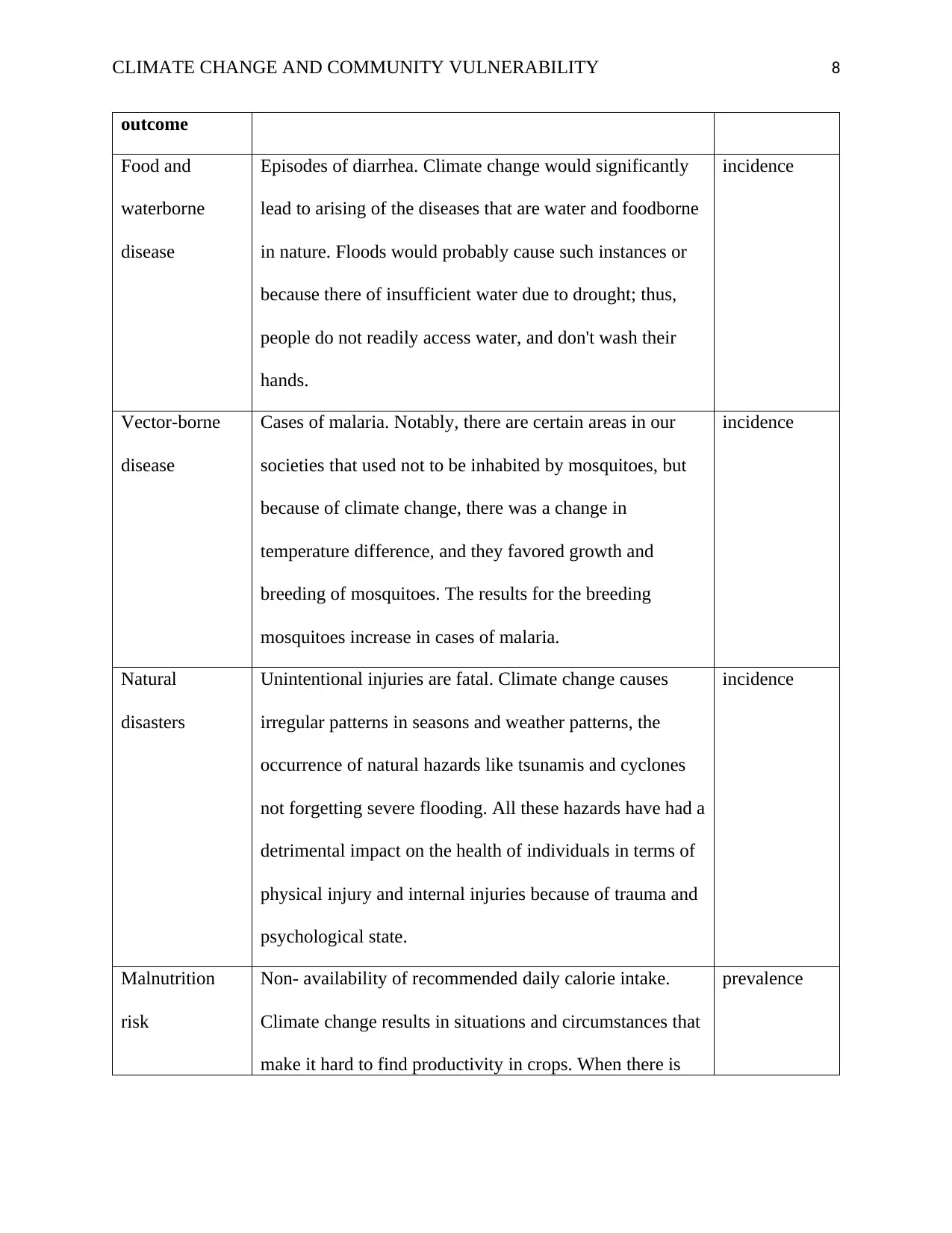
CLIMATE CHANGE AND COMMUNITY VULNERABILITY 8
outcome
Food and
waterborne
disease
Episodes of diarrhea. Climate change would significantly
lead to arising of the diseases that are water and foodborne
in nature. Floods would probably cause such instances or
because there of insufficient water due to drought; thus,
people do not readily access water, and don't wash their
hands.
incidence
Vector-borne
disease
Cases of malaria. Notably, there are certain areas in our
societies that used not to be inhabited by mosquitoes, but
because of climate change, there was a change in
temperature difference, and they favored growth and
breeding of mosquitoes. The results for the breeding
mosquitoes increase in cases of malaria.
incidence
Natural
disasters
Unintentional injuries are fatal. Climate change causes
irregular patterns in seasons and weather patterns, the
occurrence of natural hazards like tsunamis and cyclones
not forgetting severe flooding. All these hazards have had a
detrimental impact on the health of individuals in terms of
physical injury and internal injuries because of trauma and
psychological state.
incidence
Malnutrition
risk
Non- availability of recommended daily calorie intake.
Climate change results in situations and circumstances that
make it hard to find productivity in crops. When there is
prevalence
outcome
Food and
waterborne
disease
Episodes of diarrhea. Climate change would significantly
lead to arising of the diseases that are water and foodborne
in nature. Floods would probably cause such instances or
because there of insufficient water due to drought; thus,
people do not readily access water, and don't wash their
hands.
incidence
Vector-borne
disease
Cases of malaria. Notably, there are certain areas in our
societies that used not to be inhabited by mosquitoes, but
because of climate change, there was a change in
temperature difference, and they favored growth and
breeding of mosquitoes. The results for the breeding
mosquitoes increase in cases of malaria.
incidence
Natural
disasters
Unintentional injuries are fatal. Climate change causes
irregular patterns in seasons and weather patterns, the
occurrence of natural hazards like tsunamis and cyclones
not forgetting severe flooding. All these hazards have had a
detrimental impact on the health of individuals in terms of
physical injury and internal injuries because of trauma and
psychological state.
incidence
Malnutrition
risk
Non- availability of recommended daily calorie intake.
Climate change results in situations and circumstances that
make it hard to find productivity in crops. When there is
prevalence
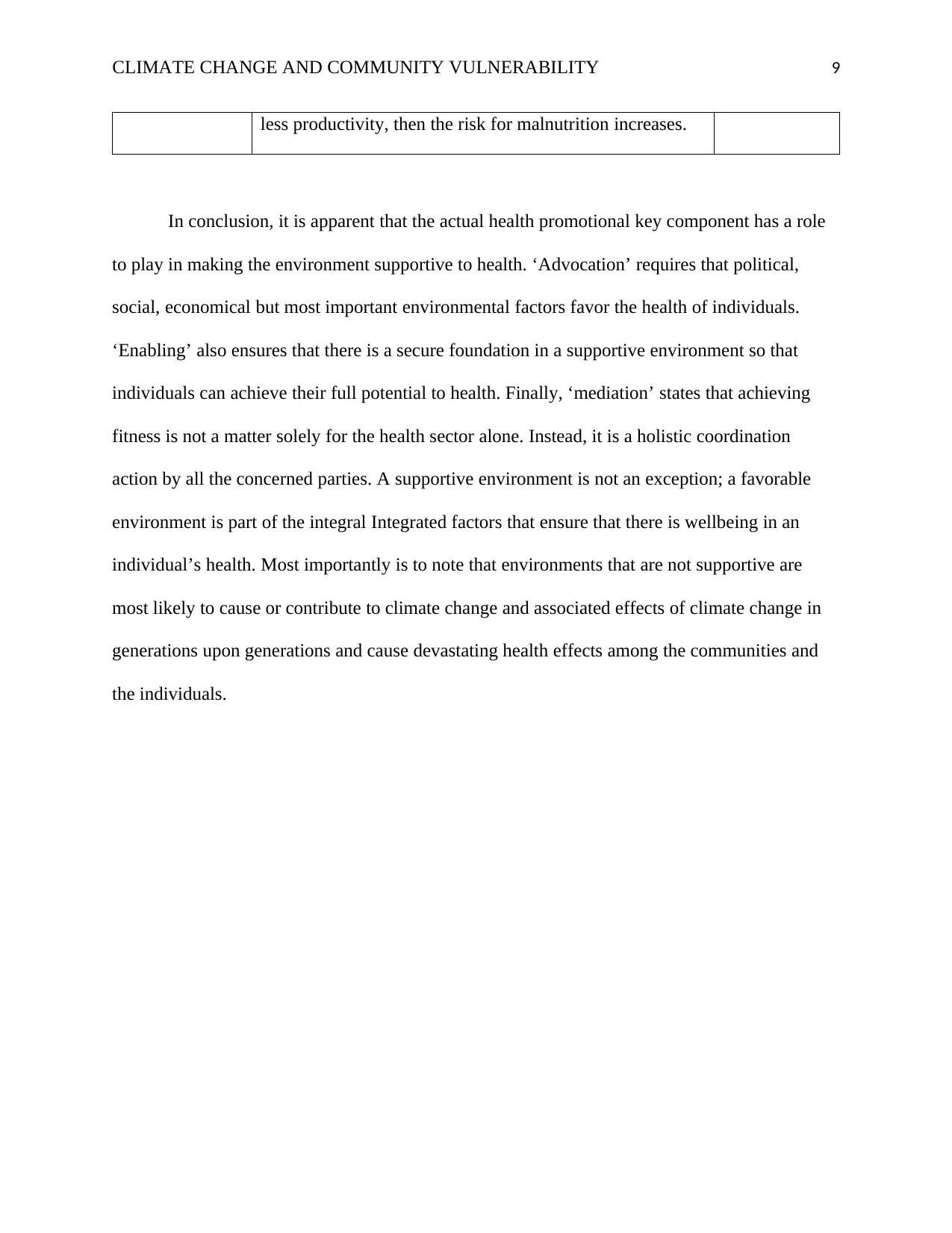
CLIMATE CHANGE AND COMMUNITY VULNERABILITY 9
less productivity, then the risk for malnutrition increases.
In conclusion, it is apparent that the actual health promotional key component has a role
to play in making the environment supportive to health. ‘Advocation’ requires that political,
social, economical but most important environmental factors favor the health of individuals.
‘Enabling’ also ensures that there is a secure foundation in a supportive environment so that
individuals can achieve their full potential to health. Finally, ‘mediation’ states that achieving
fitness is not a matter solely for the health sector alone. Instead, it is a holistic coordination
action by all the concerned parties. A supportive environment is not an exception; a favorable
environment is part of the integral Integrated factors that ensure that there is wellbeing in an
individual’s health. Most importantly is to note that environments that are not supportive are
most likely to cause or contribute to climate change and associated effects of climate change in
generations upon generations and cause devastating health effects among the communities and
the individuals.
less productivity, then the risk for malnutrition increases.
In conclusion, it is apparent that the actual health promotional key component has a role
to play in making the environment supportive to health. ‘Advocation’ requires that political,
social, economical but most important environmental factors favor the health of individuals.
‘Enabling’ also ensures that there is a secure foundation in a supportive environment so that
individuals can achieve their full potential to health. Finally, ‘mediation’ states that achieving
fitness is not a matter solely for the health sector alone. Instead, it is a holistic coordination
action by all the concerned parties. A supportive environment is not an exception; a favorable
environment is part of the integral Integrated factors that ensure that there is wellbeing in an
individual’s health. Most importantly is to note that environments that are not supportive are
most likely to cause or contribute to climate change and associated effects of climate change in
generations upon generations and cause devastating health effects among the communities and
the individuals.
⊘ This is a preview!⊘
Do you want full access?
Subscribe today to unlock all pages.

Trusted by 1+ million students worldwide
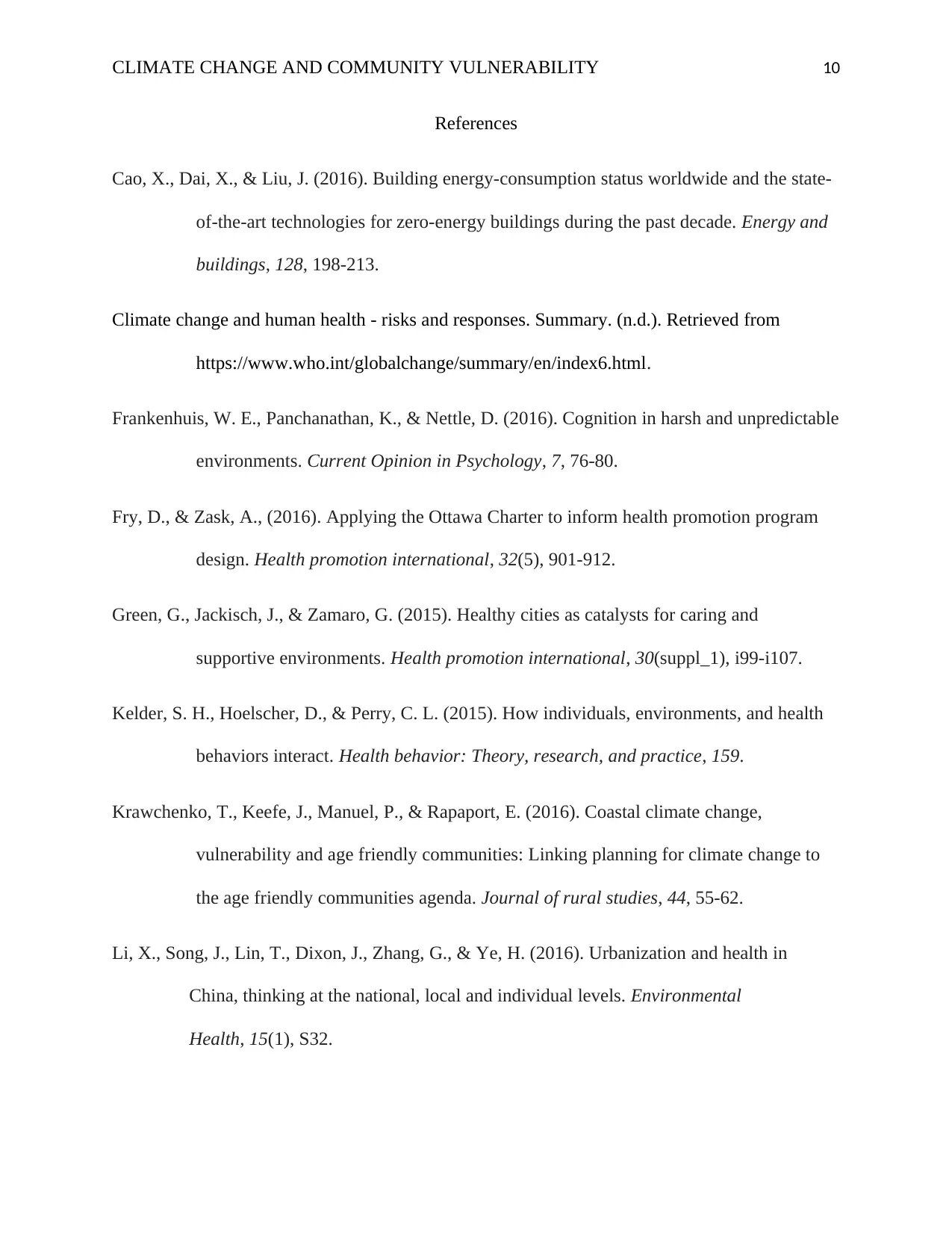
CLIMATE CHANGE AND COMMUNITY VULNERABILITY 10
References
Cao, X., Dai, X., & Liu, J. (2016). Building energy-consumption status worldwide and the state-
of-the-art technologies for zero-energy buildings during the past decade. Energy and
buildings, 128, 198-213.
Climate change and human health - risks and responses. Summary. (n.d.). Retrieved from
https://www.who.int/globalchange/summary/en/index6.html.
Frankenhuis, W. E., Panchanathan, K., & Nettle, D. (2016). Cognition in harsh and unpredictable
environments. Current Opinion in Psychology, 7, 76-80.
Fry, D., & Zask, A., (2016). Applying the Ottawa Charter to inform health promotion program
design. Health promotion international, 32(5), 901-912.
Green, G., Jackisch, J., & Zamaro, G. (2015). Healthy cities as catalysts for caring and
supportive environments. Health promotion international, 30(suppl_1), i99-i107.
Kelder, S. H., Hoelscher, D., & Perry, C. L. (2015). How individuals, environments, and health
behaviors interact. Health behavior: Theory, research, and practice, 159.
Krawchenko, T., Keefe, J., Manuel, P., & Rapaport, E. (2016). Coastal climate change,
vulnerability and age friendly communities: Linking planning for climate change to
the age friendly communities agenda. Journal of rural studies, 44, 55-62.
Li, X., Song, J., Lin, T., Dixon, J., Zhang, G., & Ye, H. (2016). Urbanization and health in
China, thinking at the national, local and individual levels. Environmental
Health, 15(1), S32.
References
Cao, X., Dai, X., & Liu, J. (2016). Building energy-consumption status worldwide and the state-
of-the-art technologies for zero-energy buildings during the past decade. Energy and
buildings, 128, 198-213.
Climate change and human health - risks and responses. Summary. (n.d.). Retrieved from
https://www.who.int/globalchange/summary/en/index6.html.
Frankenhuis, W. E., Panchanathan, K., & Nettle, D. (2016). Cognition in harsh and unpredictable
environments. Current Opinion in Psychology, 7, 76-80.
Fry, D., & Zask, A., (2016). Applying the Ottawa Charter to inform health promotion program
design. Health promotion international, 32(5), 901-912.
Green, G., Jackisch, J., & Zamaro, G. (2015). Healthy cities as catalysts for caring and
supportive environments. Health promotion international, 30(suppl_1), i99-i107.
Kelder, S. H., Hoelscher, D., & Perry, C. L. (2015). How individuals, environments, and health
behaviors interact. Health behavior: Theory, research, and practice, 159.
Krawchenko, T., Keefe, J., Manuel, P., & Rapaport, E. (2016). Coastal climate change,
vulnerability and age friendly communities: Linking planning for climate change to
the age friendly communities agenda. Journal of rural studies, 44, 55-62.
Li, X., Song, J., Lin, T., Dixon, J., Zhang, G., & Ye, H. (2016). Urbanization and health in
China, thinking at the national, local and individual levels. Environmental
Health, 15(1), S32.
Paraphrase This Document
Need a fresh take? Get an instant paraphrase of this document with our AI Paraphraser
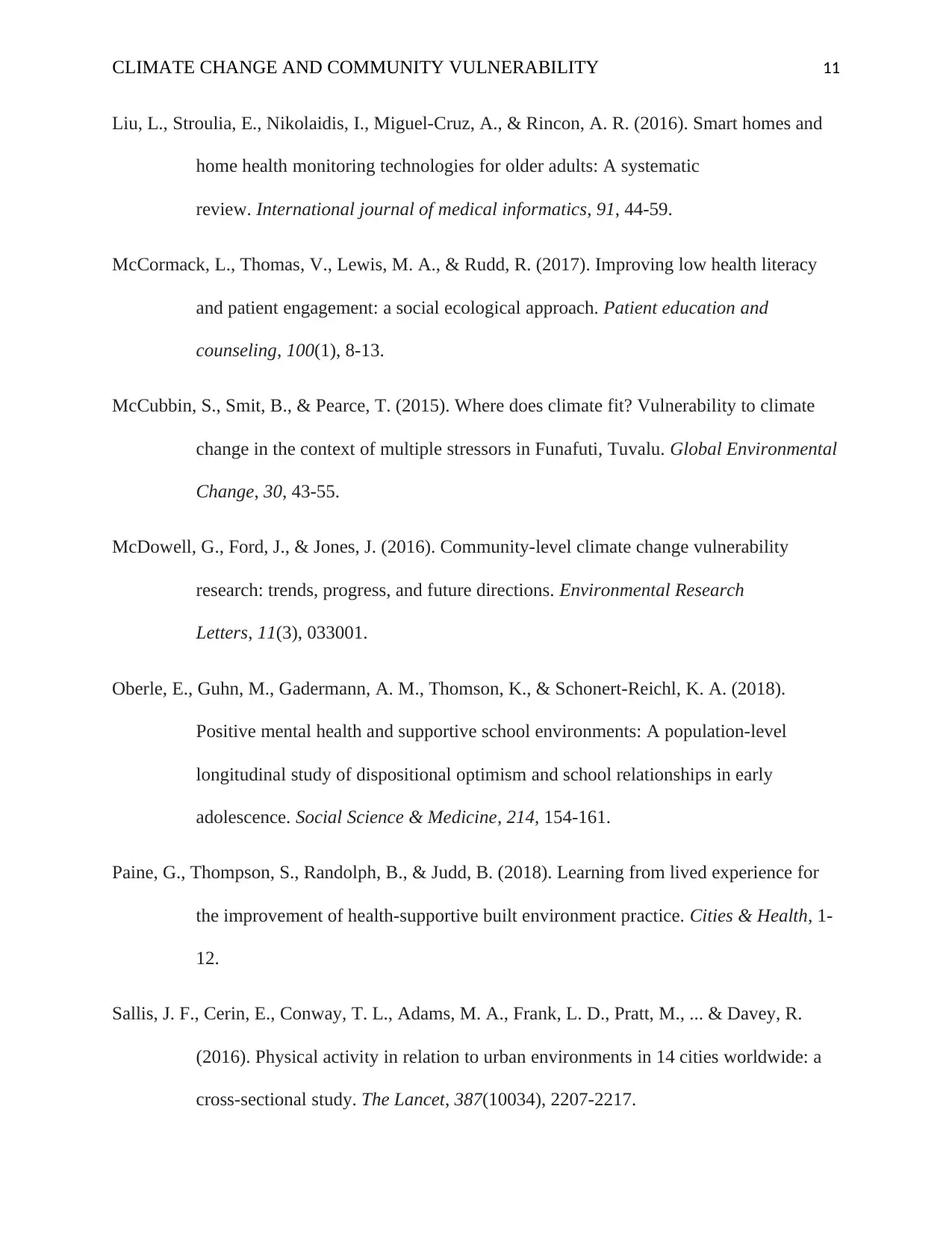
CLIMATE CHANGE AND COMMUNITY VULNERABILITY 11
Liu, L., Stroulia, E., Nikolaidis, I., Miguel-Cruz, A., & Rincon, A. R. (2016). Smart homes and
home health monitoring technologies for older adults: A systematic
review. International journal of medical informatics, 91, 44-59.
McCormack, L., Thomas, V., Lewis, M. A., & Rudd, R. (2017). Improving low health literacy
and patient engagement: a social ecological approach. Patient education and
counseling, 100(1), 8-13.
McCubbin, S., Smit, B., & Pearce, T. (2015). Where does climate fit? Vulnerability to climate
change in the context of multiple stressors in Funafuti, Tuvalu. Global Environmental
Change, 30, 43-55.
McDowell, G., Ford, J., & Jones, J. (2016). Community-level climate change vulnerability
research: trends, progress, and future directions. Environmental Research
Letters, 11(3), 033001.
Oberle, E., Guhn, M., Gadermann, A. M., Thomson, K., & Schonert-Reichl, K. A. (2018).
Positive mental health and supportive school environments: A population-level
longitudinal study of dispositional optimism and school relationships in early
adolescence. Social Science & Medicine, 214, 154-161.
Paine, G., Thompson, S., Randolph, B., & Judd, B. (2018). Learning from lived experience for
the improvement of health-supportive built environment practice. Cities & Health, 1-
12.
Sallis, J. F., Cerin, E., Conway, T. L., Adams, M. A., Frank, L. D., Pratt, M., ... & Davey, R.
(2016). Physical activity in relation to urban environments in 14 cities worldwide: a
cross-sectional study. The Lancet, 387(10034), 2207-2217.
Liu, L., Stroulia, E., Nikolaidis, I., Miguel-Cruz, A., & Rincon, A. R. (2016). Smart homes and
home health monitoring technologies for older adults: A systematic
review. International journal of medical informatics, 91, 44-59.
McCormack, L., Thomas, V., Lewis, M. A., & Rudd, R. (2017). Improving low health literacy
and patient engagement: a social ecological approach. Patient education and
counseling, 100(1), 8-13.
McCubbin, S., Smit, B., & Pearce, T. (2015). Where does climate fit? Vulnerability to climate
change in the context of multiple stressors in Funafuti, Tuvalu. Global Environmental
Change, 30, 43-55.
McDowell, G., Ford, J., & Jones, J. (2016). Community-level climate change vulnerability
research: trends, progress, and future directions. Environmental Research
Letters, 11(3), 033001.
Oberle, E., Guhn, M., Gadermann, A. M., Thomson, K., & Schonert-Reichl, K. A. (2018).
Positive mental health and supportive school environments: A population-level
longitudinal study of dispositional optimism and school relationships in early
adolescence. Social Science & Medicine, 214, 154-161.
Paine, G., Thompson, S., Randolph, B., & Judd, B. (2018). Learning from lived experience for
the improvement of health-supportive built environment practice. Cities & Health, 1-
12.
Sallis, J. F., Cerin, E., Conway, T. L., Adams, M. A., Frank, L. D., Pratt, M., ... & Davey, R.
(2016). Physical activity in relation to urban environments in 14 cities worldwide: a
cross-sectional study. The Lancet, 387(10034), 2207-2217.
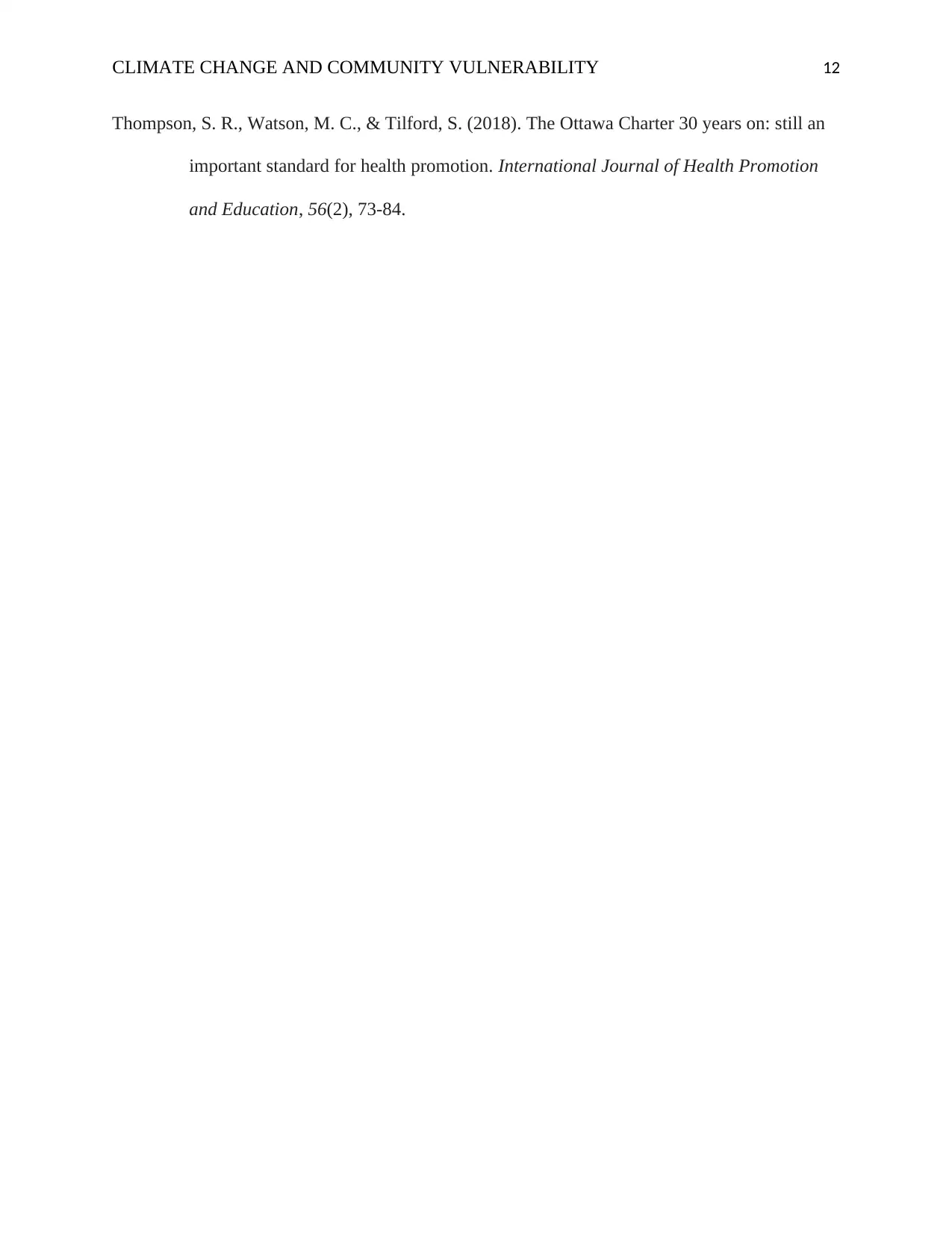
CLIMATE CHANGE AND COMMUNITY VULNERABILITY 12
Thompson, S. R., Watson, M. C., & Tilford, S. (2018). The Ottawa Charter 30 years on: still an
important standard for health promotion. International Journal of Health Promotion
and Education, 56(2), 73-84.
Thompson, S. R., Watson, M. C., & Tilford, S. (2018). The Ottawa Charter 30 years on: still an
important standard for health promotion. International Journal of Health Promotion
and Education, 56(2), 73-84.
⊘ This is a preview!⊘
Do you want full access?
Subscribe today to unlock all pages.

Trusted by 1+ million students worldwide
1 out of 12
Related Documents
Your All-in-One AI-Powered Toolkit for Academic Success.
+13062052269
info@desklib.com
Available 24*7 on WhatsApp / Email
![[object Object]](/_next/static/media/star-bottom.7253800d.svg)
Unlock your academic potential
Copyright © 2020–2025 A2Z Services. All Rights Reserved. Developed and managed by ZUCOL.





